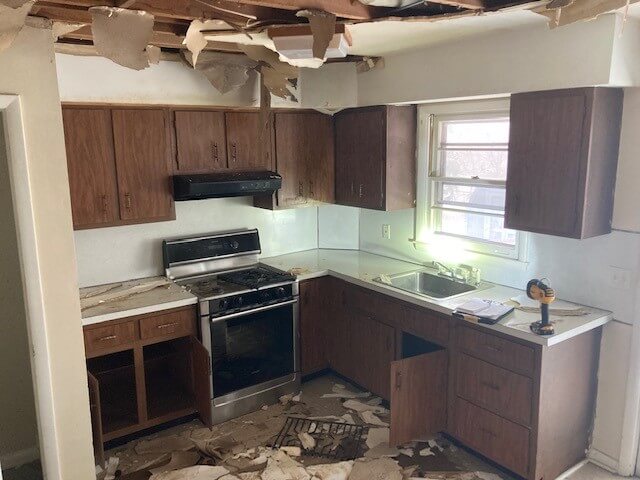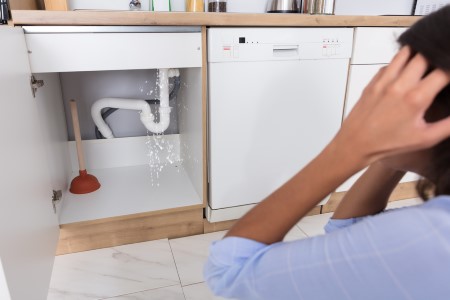This post which follows on the subject of Most Common Causes of Residential Water Damage is relatively interesting. Give it a try and make your own personal ideas.

The kitchen area is the area where a lot of water task goes on. You can barely do anything without making use of water in the kitchen area, from food preparation, cleaning, as well as doing the recipes.
Therefore, examining your kitchen once in a while is a requirement. This is because it has a higher opportunity of getting water damage because of the devices you use there.
When defective, these devices that control water might make your kitchen area unpleasant and impact the framework of your structure in the long run.
So, let's look into some causes of the water damage in the kitchen area as well as what you need to look out for.
Some Root Causes Of Water Problems in the Cooking area
These are a few reasons for water damage in the kitchen area.
Faulty Drainpipe Water Lines
Drain pipes Pipelines are necessary parts of our houses, particularly in our washrooms and also kitchens. They obtain damaged by getting blocked, cracked, and burst. Or worse, they can be wrongly or loosely linked; whichever the situation may be, it can be a serious issue.
Malfunctioning drainpipe pipelines can trigger water damage as well as, because of this, trigger mold and mildew development as well as damage the look of your wall. It can likewise make the affected area look messy.
It is suggested constantly to inspect to make sure that all the pipes are in good condition and also obtain an audio plumbing system to maintain and take care of any type of problems.
Faulty Kitchen Sink
The kitchen sink is a vital and the majority of made use of part of the cooking area. It is susceptible to water damage; damages such as blocked pipelines, dripping pipes, and faulty taps.
These problems can be frustrating, particularly when one is hectic in the kitchen area. It doesn't simply occur without providing a sign or an idea. Here are some indicators to understand when your sink is not okay
- When draining water right into the skin makes a gurgling noise and develops air bubbles while undergoing the sink. It implies that something is obstructing the pipelines of the sink.
- Another indicator of an obstructed drain is the slow-moving motion of water. Usually, water travels through a sink immediately, so if you begin observing delay, there is a clog in the pipelines.
- The next indication is an offensive smell; this shows that the pipelines are blocked, and also stale food is piling in the pipelines. This problem requires a quick fix, so the odor does not overtake your home.
- Leaking faucets and also pipes additionally can be an issue. It makes your kitchen location wet and also untidy, particularly when trickling from the pipes. And also if it is dripping from the tap, it leads to water wastefulness.
- These are the significant damages that can take place to your kitchen sink. One method to stop this damages is by ensuring that food bits do not obtain right into the pipes. You are likewise examining the pipelines and faucets as well as making sure that it is effectively repaired as well as in good condition.
Dripping Dish washer
Dishwashers make life in the cooking area easier. It is an optional kitchen home appliance as well as, when readily available, can be a resource of water damage. In addition, like other devices, it will establish mistakes with time, even with maintenance.
One of the faults is dripping through the door or beneath the dishwasher. These faults establish because of age, fractures, incorrect use, loose links to pipes, etc.
Faults because of age come from constant usage. Because of this, the door leakages because of opening up and also shutting.
Faults from the wrong usage may cause water damage by introducing cracks to it. It is suggested to follow the manual guide of the dishwasher to stop this certain damages.
The leakages under the dishwashing machine can come from cracks in the gasket, hose, and incorrect or loose connection to water pipes or drains pipes.
This sort of leakage typically goes unnoticed and can be there for a long time. Due to the time framework, it could damage the flooring as well as cause mold and mildew development.
Much more so, the longer the water stays, you will certainly observe the warping of the flooring where the dishwashing machine is. When inspecting if your dishwasher leaks, this is a good indicator to look out for. Identifying and repairing this in a timely manner prevents significant water damage to your floor covering.Bottom Line
Keeping an eye out for damages in your cooking area can be charging but essential. It makes your work there easier as well as safer.
Nonetheless, the causes detailed above are just a few factors to take into consideration, especially if your kitchen has a great deal of home appliances.
Obtain an expert pipes service to come about and examine for any damages and obtain them fixed.
It makes your kitchen location untidy and also wet, specifically when dripping from the pipelines. And if it is dripping from the tap, it leads to water wastefulness.
It is an optional kitchen home appliance and also, when available, can be a resource of water damage. Extra so, the longer the water stays, you will see the warping of the floor where the dishwashing machine is. Detecting and repairing this on time protects against serious water damage to your flooring.
Flooded Kitchen – What to Do
Coming home to a flooded kitchen can be an unpleasant surprise as you immediately start thinking about how much this problem will cost to fix. While the feeling can be frustrating, there are actually a number of steps you can take to eliminate extra time and costs when it comes to making the repairs and restoring the water damage. However, if you are able to make the repairs yourself, it is still important to have the area inspected by a professional to ensure that the problem does not return in the future.
What causes kitchen flooding?
Kitchens can flood for numerous reasons, some of which are out of the homeowner’s control. Overflowing sinks, for example, are just one cause of a kitchen flood. Clogs can send wastewater back up through the sink drain and into the kitchen.
Furthermore, kitchen faucets can leak when the pipes around the water supply line become corroded. Pipes can loosen or crack, and even new PVC pipes are vulnerable to developing small cracks. When gaskets wear out along areas where the pipe meets the faucet, leaks and subsequent flooding can occur.
How to clean up kitchen flood?
If the flooded area is not severe, you may be able to dry it out yourself with a mop and bucket; however, for larger areas, don’t hesitate to call a water damage restoration professional. In addition, if you can see that the problem has been ongoing for a few days or more, you will want to contact a mold remediation professional as it is likely that the fungus has developed over time. But while waiting for the technicians to arrive, you can get a head start on the drying process by taking the following steps:
- Remove all excess water. If you have a shop vac that is able to remove water, this would be the most efficient tool. Otherwise, a mop and a bucket will be handy.
- Increase air flow. After the excess water has been removed, it is likely that the building materials and furnishings are still wet. To dry them out, turn on the air conditioner or dehumidifier. If weather conditions are dry, open the exterior windows to allow for additional air to circulate the property. However, if sewage water has seeped into the air conditioning unit, do not use it.
- Open drawers and cabinets. Moisture can easily accumulate within these smaller areas; be sure that they are all open to allow dry air to flow throughout the space.
- Avoid damaged electrical items. If any kitchen appliances, such as the toaster, blender, microwave, oven, etc. have been damaged by the water, do not use them. Have them inspected by a professional to determine if they are safe to reuse.
- Do not lay down magazines or newspaper. Although paper is quick to retain water, the ink will quickly bleed onto the floor and cause a bigger mess.
- Dry off wet furniture. If any upholstery has been damaged from the water, wipe them down thoroughly. But be careful when drying off wood furniture; this type of material becomes severely weakened after having contact with water.
How to Clean Wet Cabinets in a Flooded Kitchen
A flood caused by any of the abovementioned scenarios will lead to water damaged kitchen cabinets. Cleaning the water damaged cabinets right away is important since water damage spreads quickly. Whether the cabinets are made of wood or plywood, proper cleaning tactics help salvage them.
Upon removing the standing water, remove the cabinet doors and dry them with a household fan. Keep the cabinet doors flat to prevent warping. The cabinets should also be dried—however, with multiple high-volume fans and a dehumidifier that run over the course of one full day.
https://restorationmasterfinder.com/restoration/flooded-kitchen-what-to-do/

Hopefully you liked our article on Causes of Water Damage in Kitchen. Many thanks for taking time to read our post. Sharing is caring. You just don't know, you may be helping someone out. We take joy in reading our article about Causes of Water Damage in Kitchen.
Website
Comments on “Common Causes of Water Damage in Kitchen”